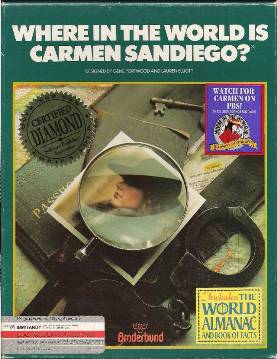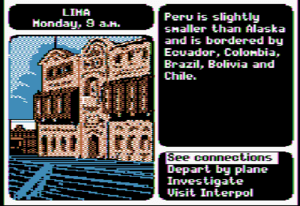Where in the World Is Carmen Sandiego? (1985 video game) facts for kids
Quick facts for kids Where in the World isCarmen Sandiego? |
|
|---|---|
 |
|
| Developer(s) | Broderbund |
| Publisher(s) | Broderbund |
| Series | Carmen Sandiego |
| Platform(s) |
Apple II, DOS, Commodore 64, Master System, Amstrad CPC, TRS-80 CoCo
|
| Release date(s) |
1985 (original)
1989 (updated)
1991 (version 2.2) 1993 (version 2.5) |
| Genre(s) | Educational/strategy |
| Mode(s) | Single-player |
Where in the World is Carmen Sandiego? is an educational video game released by Broderbund in 1985. It is the first product in the Carmen Sandiego franchise. The game was distributed with The World Almanac and Book of Facts, published by Pharos Books. An enhanced version of the game was released in 1989, which did not have the almanac-based copy protection and instead used disk-based copy protection. A deluxe version was released in 1992, and featured additional animation and a reworked interface from the original version. Some of the bonus features included digitized photos from National Geographic, over 3200 clues, music from the Smithsonian/Folkways Recordings, 20 villains, 60 countries, and 16 maps. CD-ROM versions for DOS and Macintosh were released in 1992, and a Windows version was released in 1994.
In the game, the player takes the role of a rookie in the fictional ACME Detective Agency, tasked to track down crooks from the V.I.L.E. organization who have stolen famous works from around the world. They do this by using their knowledge of geography (aided by the Almanac) to question witnesses or investigate clues to track down where the crook has gone. Successfully solving these crimes increases the player's rank in ACME, leading to more difficult cases and later tasked to find the leader of V.I.L.E. and namesake, Carmen Sandiego.
The game was initially developed as a menu-driven interface to replace the text-driven interface of adventure games like Colossal Cave Adventure for graphic-enabled computers like the Apple II. Along the way, the idea of introducing geography as part of the game and distributing the Almanac with the game shifted its approach. While it was not intended as an educational game at release, the game proved very successful as an educational tool for schools. By 1995, over four million copies of the game had been sold, and established the Carmen Sandiego franchise. This game is not to be confused with the 1996 rebooted version sometimes mistakenly called the "Deluxe" version.
Plot and gameplay
The goal of the game is to track down Carmen Sandiego's villains around the world, arrest them and later capture Carmen herself. The player begins the game by first going to the country where the crime took place and then obtaining hints from various sources on where the thief went next, leading to a chase around the world to find the thief before time runs out. Each case begins with the user being alerted that a spectacular theft has been committed. Starting by first traveling to the scene of the crime, the player is given several opportunities to collect clues about the suspect's next location, which come in the form of pun-filled word play about the target place. There are thirty countries that can be visited in the game and each is identified by the name of a prominent city, though this city is not always consistent with the image of the country shown in the game.
If the player travels to an incorrect location, they receive nonsensical clues and will have to backtrack to the previous location to try again. If the player travels to the correct location, a simple animation of an obvious, but otherwise harmless V.I.L.E. henchman lurking across the screen is played. The gameplay continues to repeat in this manner as the player travels from location to location several times before catching up to the criminal. The user has only a limited amount of in-game time to travel, collect clues, and apprehend the criminal; every action taken uses up a portion of this time, and the criminal escapes if it runs out.
Occasionally, a witness will give a partial description of the criminal, allowing the user to eliminate one or more V.I.L.E. members as suspects. When only one viable suspect remains, Interpol issues an "arrest warrant" (the in-game equivalent of an Interpol "Red Notice") against that individual. If the user enters a combination of attributes that eliminates all possible members of the database, the game will inform the user to that effect and refuse to issue any warrant. Once the user reaches the final destination (indicated by witnesses warning the user to be careful) and chooses the correct location, the police chase the criminal across the screen, leading to an off-screen fight. If the user has obtained a warrant for the correct suspect, the police place the criminal under arrest and the case is closed. Otherwise, the police are left empty-handed and the criminal escapes.
The user becomes eligible for promotion after solving enough cases. Before the new rank is granted, though, the user must correctly answer a geography question with the help of a reference book included with the program (used as a form of protection against disk copying). Each rank gives harder assignments with more potential locations to visit. The culprit in the final case is Carmen Sandiego herself; apprehending her earns the user a spot in the game's Hall of Fame.
The Master System version plays quite differently compared to the other versions. Instead of using a menu-based system, a sprite character representing the user can be moved to the respective buildings within a country, to get a warrant or back to the airport to travel. The user must duck or jump knife attacks from henchmen and gun attacks from Carmen's gang, and will lose some time recovering if hit.
Deluxe version
| Where in the World Is Carmen Sandiego? Deluxe | |
|---|---|
| Developer(s) | Brøderbund Software |
| Publisher(s) | Brøderbund Software |
| Series | Carmen Sandiego |
| Platform(s) | DOS, FM Towns, Microsoft Windows, Mac OS |
| Release date(s) | 1992 |
| Genre(s) | Educational/strategy |
| Mode(s) | Single-player |
Where in the World is Carmen Sandiego? Deluxe, on CD-ROM, adds digitized photographs from the National Geographic Society and music from Smithsonian/Folkways. Each location contains three sources of clues: The user can question a bystander, search the area, or call "Crime Net". Bystanders and "Crime Net" provide clues as to the suspect's location and, on occasion, additionally state something about the suspect. Searching an area along the perpetrator's path turns up an object that provides a clue as to the suspect's location. The Deluxe edition is the first in the series to feature dialogue spoken aloud, although most information still appears in written form and the dialogue of bystanders is not spoken but rather contained in speech balloons.
Locations
This is a list of the thirty locations visited in the game, organized in alphabetical order by country. Note that cities are identified as they were in the game and that they are followed by the country that the city would have been located in at the time the game was produced.
|
|
||
|---|---|---|


